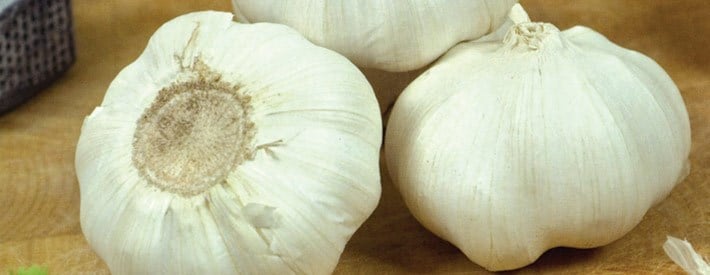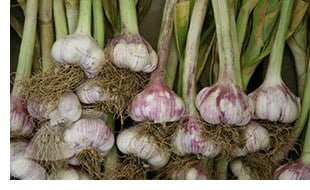Garlic rust

My garlic has turned ginger. And not in a good way.
It happened just about overnight. One day I had perfectly healthy, sturdy garlic shoots: the next day the foliage was a bilious shade of orange. On closer inspection, it was covered in little raised bumps and pustules the exact same shade as rusty metal. There are few diseases more easily identifiable.
 I’m reliably informed by Wikipedia that there are 7000 species of rust. I can entirely believe it. It’s one of the most common fungal diseases you can get in the veg garden, or indeed anywhere in the garden: I’ve had rust on my hollyhocks too, and it also affects pelargoniums, mint, lawns, fuchsias and pear trees (this last with the rather eccentric habit of spending part of its lifecycle on juniper bushes – so you need both plants for it to flourish).
I’m reliably informed by Wikipedia that there are 7000 species of rust. I can entirely believe it. It’s one of the most common fungal diseases you can get in the veg garden, or indeed anywhere in the garden: I’ve had rust on my hollyhocks too, and it also affects pelargoniums, mint, lawns, fuchsias and pear trees (this last with the rather eccentric habit of spending part of its lifecycle on juniper bushes – so you need both plants for it to flourish).
On the plus side, each type of rust is very, very specialised. So I can’t blame the hollyhocks for infecting my garlic: hollyhock rust (Puccinia malvacearum) only likes hollyhocks. This is garlic rust, Puccinia allii, and it mainly likes leeks and garlic (it can also infect onions, but for some unexplained reason chooses not to in the UK: perhaps it just finds garlic tastier).
It’s far more likely the spores arrived on my garlic on the feet of insects. It might have been blown there, though that’s less likely as we’re a little way from the nearest veg garden and there is nothing behind the garlic in the prevailing wind direction but a hedge. The wind was probably, however, responsible for spreading the rust from plant to plant.
Rust spores infect perfectly healthy plants and by the time you see that characteristic orange colour they’ll have been having a ball with your plants’ leaves for about two weeks. By this time it is too late: they are well away and spreading their nasty little fungal babies far and wide.
 And here’s the bad news: there’s pretty much no cure. You can remove rusted leaves if you spot them soon enough, but you’re just delaying the inevitable. There’s nothing you can spray it with; no clever little hand-me-down gardening wisdom. There aren’t really even any cultivation tricks you can use to keep it at bay: yes, it’s worse in over-fertilised soils so you shouldn’t overdo the nitrogen, but I haven’t fed my garlic at all and they still succumbed. Nor were they crowded, nor overwatered as they usually are in our damp corner of the UK; it’s been the driest summer for ages.
And here’s the bad news: there’s pretty much no cure. You can remove rusted leaves if you spot them soon enough, but you’re just delaying the inevitable. There’s nothing you can spray it with; no clever little hand-me-down gardening wisdom. There aren’t really even any cultivation tricks you can use to keep it at bay: yes, it’s worse in over-fertilised soils so you shouldn’t overdo the nitrogen, but I haven’t fed my garlic at all and they still succumbed. Nor were they crowded, nor overwatered as they usually are in our damp corner of the UK; it’s been the driest summer for ages.
So I’m feeling a little peeved. I haven’t done anything wrong, yet my poor garlic bulbs have been stopped in their tracks. I’ve harvested what I can, but it’s weeks earlier than they’d usually be leaving the ground: no wonder the cloves are so small. The only thing I can do is pick up every last bit of dusty orange foliage and keep it religiously out of the compost, as this is a disease that will overwinter if you let it.
Though there aren’t any varieties of garlic which show resistance to rust, one way around re-infection next year is to grow your garlic fast and early, so that by the time rust gets busy in around May they’re already well developed. There’s just one variety which crops in double-quick time: so next year I’ll be growing ‘Early Purple Wight’, ready to pull by May so by the time the orange dust arrives the plate will be empty. That should foil the little blighters.




 I’m reliably informed by Wikipedia that there are 7000 species of rust. I can entirely believe it. It’s one of the most common fungal diseases you can get in the veg garden, or indeed anywhere in the garden: I’ve had rust on my
I’m reliably informed by Wikipedia that there are 7000 species of rust. I can entirely believe it. It’s one of the most common fungal diseases you can get in the veg garden, or indeed anywhere in the garden: I’ve had rust on my  And here’s the bad news: there’s pretty much no cure. You can remove rusted leaves if you spot them soon enough, but you’re just delaying the inevitable. There’s nothing you can spray it with; no clever little hand-me-down gardening wisdom. There aren’t really even any cultivation tricks you can use to keep it at bay: yes, it’s worse in over-fertilised soils so you shouldn’t overdo the nitrogen, but I haven’t fed my
And here’s the bad news: there’s pretty much no cure. You can remove rusted leaves if you spot them soon enough, but you’re just delaying the inevitable. There’s nothing you can spray it with; no clever little hand-me-down gardening wisdom. There aren’t really even any cultivation tricks you can use to keep it at bay: yes, it’s worse in over-fertilised soils so you shouldn’t overdo the nitrogen, but I haven’t fed my 